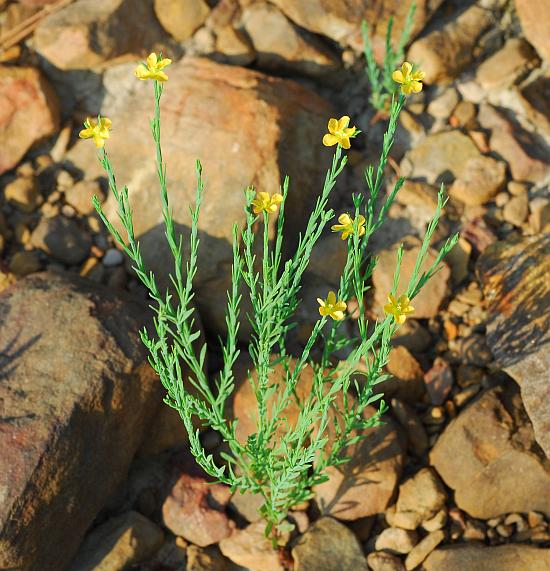Hypericum drummondii (Grev. & Hook.) Torr. & A. Gray
Nits And Lice

Native
CC = 4
CW = 3
MOC = 62
© SRTurner
Hypericum drummondii (Grev. & Hook.) Torr. & A. GrayNits And Lice | |
 |
Native CC = 4 CW = 3 MOC = 62 |
© SRTurner |
|
Family - Hypericaceae Habit - Taprooted annual forb, usually with numerous ascending branches. Stems - Ascending to erect, to 40 cm, angled or slightly ridged below each leaf toward the tip, with minute, yellowish brown to dark green or black resinous dots, green to reddish brown, sometimes turning orangish brown with age, sometimes peeling in thin strips with age.
Leaves - Opposite, simple, sessile. Blades 5-22 mm long, 0.5-1.5 mm wide, linear, needlelike, bluntly to sharply pointed at the tip, tapered or narrowed at the base, the margins somewhat rolled under at maturity, somewhat leathery in texture, with 1 main vein visible, the surfaces with minute, yellowish brown to dark green or black resinous dots, the upper surface green, the undersurface usually somewhat paler but not glaucous.
Inflorescences - Mostly solitary flowers in the leaf axils or branch tips, sometimes with small, loose clusters of 3 or 5 flowers.
Flowers - Actinomorphic. Sepals 5, all more or less similar in size and shape, 3-7 mm long, narrowly lanceolate to narrowly oblong-lanceolate, with minute, yellowish brown to black dots, lines, and/or streaks. Petals 5, 4-7 mm long, oblong-obovate, orangish yellow, withered and inconspicuous but usually persistent at fruiting. Stamens 10-22, the filaments sometimes irregularly spaced but usually not fused into groups. Ovary 1-locular, with parietal placentation. Styles 3, free above the base, more or less spreading, the stigmas capitate.
Fruits - Capsules 4.5-7.0 mm long, at maturity as long as or slightly longer than the sepals, narrowly ovoid, widest slightly below the midpoint, tapered to the persistent styles, more or less circular in cross-section. Seeds numerous, 0.9-1.1 mm long, the surface with a coarse network of ridges and pits, light brown to dark brown.
Flowering - June - September. Habitat - Glades, upland prairies, ledges and tops of bluffs, upland forest openings, savannas, fields. Usually on acidic substrates. Origin - Native to the U.S. Lookalikes - Species of Linum such as L. medium, also Oenothera linifolia. Other info. - This little species can be found in much of Missouri but appears to be absent in the northwestern 1/3 of the state. Beyond Missouri it is found across much of the southeastern quadrant of the continental U.S. The plant is easy to identify from its small size, much-branched stems, linear, opposite leaves, and small yellow flowers. The presence of resinous and/or pellucid dots on the leaves differentiate Hypericum from most other genera. Photographs taken off Lee Rd 54, Lee County, AL., 8-24-04 (DETenaglia); also at McGee Creek State Park, Atoka County, OK, 7-26-2016, and Don Robinson State Park, Jefferson County, MO, 9-6-2021 (SRTurner). |